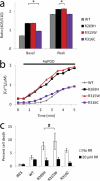Mutant TRPV4-mediated toxicity is linked to increased constitutive function in axonal neuropathies
- PMID: 21454511
- PMCID: PMC3089570
- DOI: 10.1074/jbc.M111.237685
Mutant TRPV4-mediated toxicity is linked to increased constitutive function in axonal neuropathies
Abstract
Mutations in TRPV4 have been linked to three distinct axonal neuropathies. However, the pathogenic mechanism underlying these disorders remains unclear. Both gain and loss of calcium channel activity of the mutant TRPV4 have been suggested. Here, we show that the three previously reported TRPV4 mutant channels have a physiological localization and display an increased calcium channel activity, leading to increased cytotoxicity in three different cell types. Patch clamp experiments showed that cells expressing mutant TRPV4 have much larger whole-cell currents than those expressing the wild-type TRPV4 channel. Single channel recordings showed that the mutant channels have higher open probability, due to a modification of gating, and no change in single-channel conductance. These data support the hypothesis that a "gain of function" mechanism, possibly leading to increased intracellular calcium influx, underlies the pathogenesis of the TRPV4-linked axonal neuropathies, and may have immediate implications for designing rational therapies.
Figures










Similar articles
-
Mutations in calmodulin-binding domains of TRPV4/6 channels confer invasive properties to colon adenocarcinoma cells.Channels (Austin). 2020 Dec;14(1):101-109. doi: 10.1080/19336950.2020.1740506. Channels (Austin). 2020. PMID: 32186440 Free PMC article.
-
Functional coupling of TRPV4 cationic channel and large conductance, calcium-dependent potassium channel in human bronchial epithelial cell lines.Pflugers Arch. 2008 Oct;457(1):149-59. doi: 10.1007/s00424-008-0516-3. Epub 2008 May 6. Pflugers Arch. 2008. PMID: 18458941
-
Dynamic coupling between TRPV4 and Ca2+-activated SK1/3 and IK1 K+ channels plays a critical role in regulating the K+-secretory BK channel in kidney collecting duct cells.Am J Physiol Renal Physiol. 2017 Jun 1;312(6):F1081-F1089. doi: 10.1152/ajprenal.00037.2017. Epub 2017 Mar 8. Am J Physiol Renal Physiol. 2017. PMID: 28274924 Free PMC article.
-
Mutations in TRPV4 cause an inherited arthropathy of hands and feet.Nat Genet. 2011 Oct 2;43(11):1142-6. doi: 10.1038/ng.945. Nat Genet. 2011. PMID: 21964574
-
Emerging roles of calcium-activated K channels and TRPV4 channels in lung oedema and pulmonary circulatory collapse.Acta Physiol (Oxf). 2017 Jan;219(1):176-187. doi: 10.1111/apha.12768. Epub 2016 Sep 16. Acta Physiol (Oxf). 2017. PMID: 27497091 Review.
Cited by
-
Local control of TRPV4 channels by AKAP150-targeted PKC in arterial smooth muscle.J Gen Physiol. 2014 May;143(5):559-75. doi: 10.1085/jgp.201311050. J Gen Physiol. 2014. PMID: 24778429 Free PMC article.
-
Activation of Transient Receptor Potential Vanilloid 4 Impairs the Dendritic Arborization of Newborn Neurons in the Hippocampal Dentate Gyrus through the AMPK and Akt Signaling Pathways.Front Mol Neurosci. 2017 Jun 15;10:190. doi: 10.3389/fnmol.2017.00190. eCollection 2017. Front Mol Neurosci. 2017. PMID: 28663724 Free PMC article.
-
Clinical Characteristics and Whole Exome Sequencing Analysis in Serbian Cases of Clubfoot Deformity-Single Center Study.Children (Basel). 2024 May 27;11(6):647. doi: 10.3390/children11060647. Children (Basel). 2024. PMID: 38929227 Free PMC article.
-
The implementation and utility of clinical exome sequencing in a South African infant cohort.Front Genet. 2023 Nov 9;14:1277948. doi: 10.3389/fgene.2023.1277948. eCollection 2023. Front Genet. 2023. PMID: 38028619 Free PMC article.
-
Identification and Properties of TRPV4 Mutant Channels Present in Polycystic Kidney Disease Patients.Function (Oxf). 2024 Sep 10;5(5):zqae031. doi: 10.1093/function/zqae031. Function (Oxf). 2024. PMID: 38984987 Free PMC article.
References
-
- DeLong R., Siddique T. (1992) Arch. Neurol. 49, 905–908 - PubMed
-
- Dyck P. J., Litchy W. J., Minnerath S., Bird T. D., Chance P. F., Schaid D. J., Aronson A. E. (1994) Ann. Neurol. 35, 608–615 - PubMed
-
- Isozumi K., DeLong R., Kaplan J., Deng H. X., Iqbal Z., Hung W. Y., Wilhelmsen K. C., Hentati A., Pericak-Vance M. A., Siddique T. (1996) Hum. Mol. Genet. 5, 1377–1382 - PubMed
-
- Klein C. J., Cunningham J. M., Atkinson E. J., Schaid D. J., Hebbring S. J., Anderson S. A., Klein D. M., Dyck P. J., Litchy W. J., Thibodeau S. N. (2003) Neurology 60, 1151–1156 - PubMed
-
- McEntagart M. E., Reid S. L., Irrthum A., Douglas J. B., Eyre K. E., Donaghy M. J., Anderson N. E., Rahman N. (2005) Ann. Neurol. 57, 293–297 - PubMed
Publication types
MeSH terms
Substances
Grants and funding
LinkOut - more resources
Full Text Sources
Other Literature Sources
Medical

